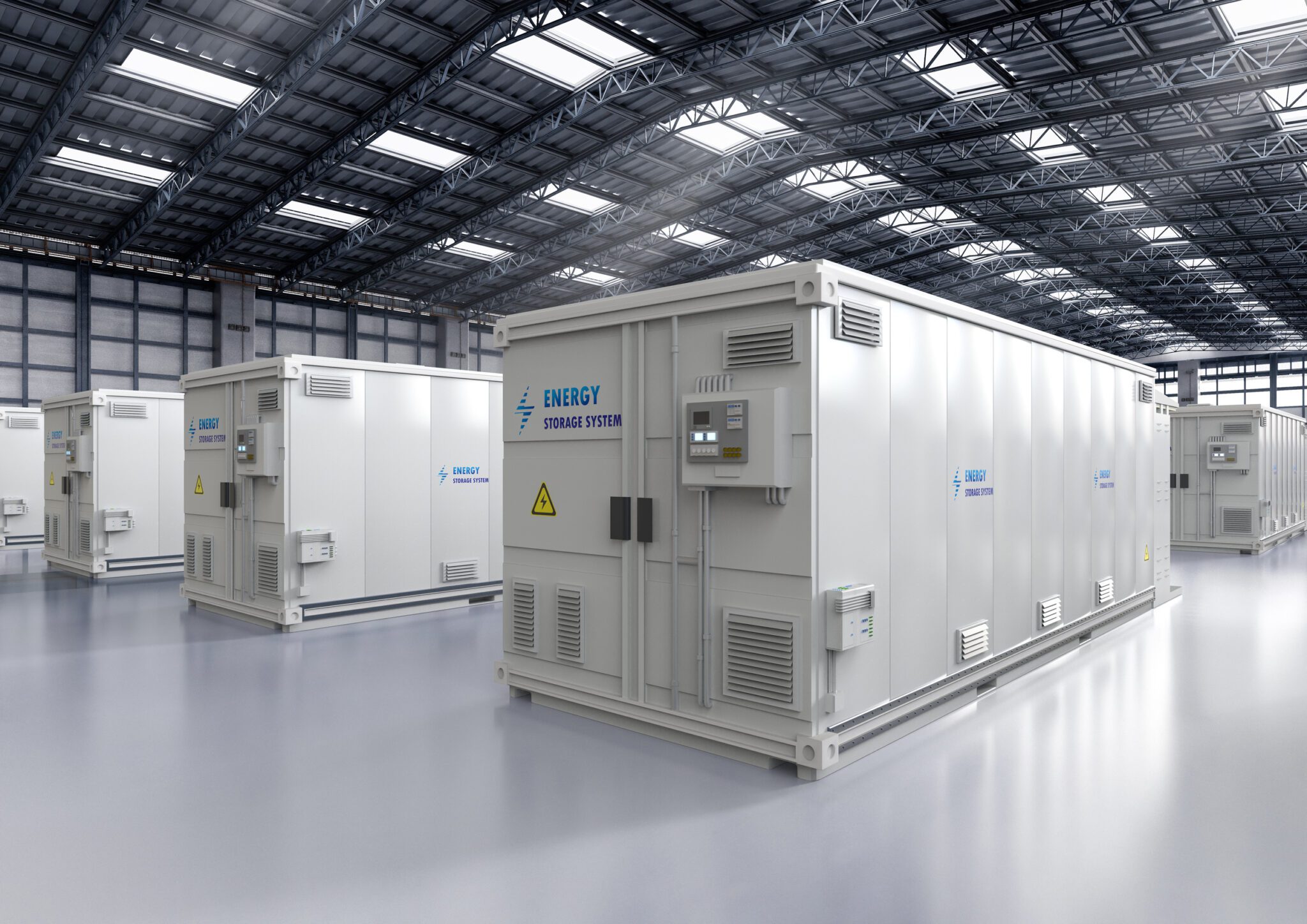Supply and demand affect the distribution of electricity. Production rates vary; consumption rates vary. Battery energy storage systems (BESS) help balance these fluctuations. There are several energy storage types, including hydroelectric, compressed air, flywheel and thermal storage.
One energy storage type is growing in popularity: batteries. Grid-scale battery storage systems collect and hold electricity for later use. Power can flow in multiple directions with batteries—instead of only from generation to the end consumer.
BESS energy storage provides better reliability, reduces brownouts and allows operators to integrate more energy sources into the mix.
Dive in for more on BESS batteries, and explore the components of a BESS battery system.
Types of BESS Batteries
A battery has multiple electrochemical cells. Each cell includes two electrodes: an anode (negative) and a cathode (positive).
Add a pathway that can conduct electricity, and electrodes will flow across it. The anode creates free electrons that help energy move to an external circuit—or whatever is being powered.
BESS batteries can be made of many materials. The most popular battery material on the market now is lithium-ion.
Lithium-Ion Batteries
Since they have a longer charge and lifespan, many battery energy storage systems, electric vehicles and plug-in hybrid vehicles employ lithium-ion batteries.
Lithium-ion batteries store more energy within the same physical space as other batteries. The downside to lithium-ion batteries is that they have a flammable electrolyte, so higher safety standards are a must.
Nickel–Cadmium Batteries
Before the growing demand for lithium-ion batteries, nickel-cadmium batteries were popular for many rechargeable and portable devices. They discharge similarly to lithium-ion batteries while using pocket-plate technology; however, they have a lower energy density.
Many batteries still employ nickel components in cathodes. Lithium batteries may use lithium nickel manganese cobalt oxide or lithium nickel cobalt aluminum cathodes.
Lead Batteries
Lead batteries are reliable, initially less expensive and have been used for many purposes over time. Lead reacts with sulfuric acid upon discharge, producing lead sulfate and water.
These batteries store and discharge energy similarly to other battery types but do not perform as well or last as long as lithium-ion batteries.
Parts of a Battery Energy Storage System
Every battery energy storage system contains several connected batteries. They are configured to reach a specific current and voltage. Beyond the batteries, energy storage systems require several components to work their magic.
Battery Management System (BMS)
Monitoring battery health and performance is essential! A battery management system (BMS) watches over the batteries, checking their vitals periodically.
The system ensures each battery cell operates at the proper voltage, current and temperature for the best performance. A battery management system can help prevent fires and other hazards from occurring.
Power Conversion System (PCS)
A BESS stores and releases electricity as direct current (DC). Most electrical loads, however, operate on alternating current (AC). Something has to convert DC to AC and vice versa. Power conversion systems (PCS) or inverters do just that.
Batteries must be able to charge and discharge. A power conversion system changes DC from the batteries to AC for grid loads. Many battery energy storage systems have bi-directional inverters because energy must flow to and from the battery.
Supervisory Control and Data Acquisition System (SCADA)
A battery management system keeps track of all the batteries. Consider the SCADA system the next step up on the BESS career ladder—it keeps track of all the system’s components. The control system talks to the storage system, electric meters and transformers.
Energy Management System (EMS)
An energy management system (EMS) controls the flow of energy. Think of it as the senior manager asking the junior managers—the BMS and SCADA—for their feedback.
The energy management system talks to other components to collect data and distribute power. An EMS controls and schedules energy discharges using information from the electric grid, transformers and loads.
HVAC
We’ve discussed several control and management features, but BESS safety features are just as important. You don’t want batteries getting too hot—they could catch fire or stop performing at the same rate.
Grid-scale batteries rely on HVAC systems to maintain optimal environments. HVAC systems keep air moving inside and outside of the BESS. Avoiding overheating batteries prolongs their lifespans.
Fire Suppression
Excessive heat isn’t suitable for battery operations. As battery temperature and pressure increase, thermal runaway becomes a concern. Thermal runaway occurs when batteries release flammable gases, which can result in a fire or explosion.
A BESS should have fire suppression features where the system turns off if temperatures reach a certain point. Many systems release cooling agents to help quell potential flames.
6 BESS Applications
In the past, we couldn’t store electricity. Now, we can. Battery energy storage creates opportunities to provide more reliable power, connect with more resources and avoid outages. It also gives the consumer a chance to take ownership of their energy if they can feed energy back to the grid.
How can you use BESS energy storage?
1. Energy Arbitrage
Electricity prices have always been dependent on demand. Electricity is more expensive when more people use it, like on a sweltering July afternoon. It’s less costly at non-peak times. Arbitrage is a way for operators to take advantage of these fluctuations.
Energy arbitrage refers to charging a battery energy storage system at non-peak times when electricity costs less. During high demand times—when electricity is pricier—operators can discharge and sell that energy at higher prices.
2. Firm/Peaking Capacity
Historically, higher demand periods strain resources, decreasing reliability. At these times, operators must ensure they have enough energy.
Resources fluctuate. The energy generated at a given time may not meet capacity needs and demand. Battery energy storage systems add to operators’ total energy capacity.
Using a BESS helps provide power when needed to meet peak demand. Similarly, when using resources like solar, a BESS fills gaps in the energy supply.
3. Non-Wires Alternative
Transmission and distribution lines are expensive to maintain and set up as cities grow. The country’s current transmission lines are aging, with over 70% of them in the second half of their lives.
Energy storage helps circumvent the need for new lines. BESS energy storage adds capacity and reduces the load on transmission and distribution systems at peak times.
4. Ancillary Services
Reliable power has one requirement: Generation must match demand all the time. Some systems discharge power in sub-seconds, others in hours. A BESS discharges energy in under a second and supports energy operations.
Integrating a BESS enables systems to offer additional services like load regulation, voltage support and spinning and non-spinning reserves.
5. Backup Power
Grid failure can happen. You want to be ready if it does. Weather, problems with equipment and other factors can affect the system’s ability to generate and distribute power.
A BESS can supply power until the grid is back up and running. By integrating a BESS with other power sources, you can have uninterrupted power in times of crisis. Stored energy ensures your plant or company doesn’t experience downtime.
6. Black Start
Before power plants produce energy, they need electricity to start up. What happens when no electricity is available?
After a blackout, power plants need power to resume generation. Many power companies use gas generators to kickstart production if the operation has shut down. Plants can also use battery storage systems for this purpose.
Using a BESS can have the plant back up quickly without gas costs.
Custom Fabrication for Energy Storage
Need energy storage components? Let’s talk. We help battery energy storage system manufacturers make equipment.
Metaltech Products is a complete metal fabrication company. Our capable, family-owned business provides ready-to-install parts for manufacturers. Our services range from design to welding to powder coating.
Request a quote online, or call us at 417-426-5577. You can rely on our team’s metal manufacturing expertise and craftsmanship.






